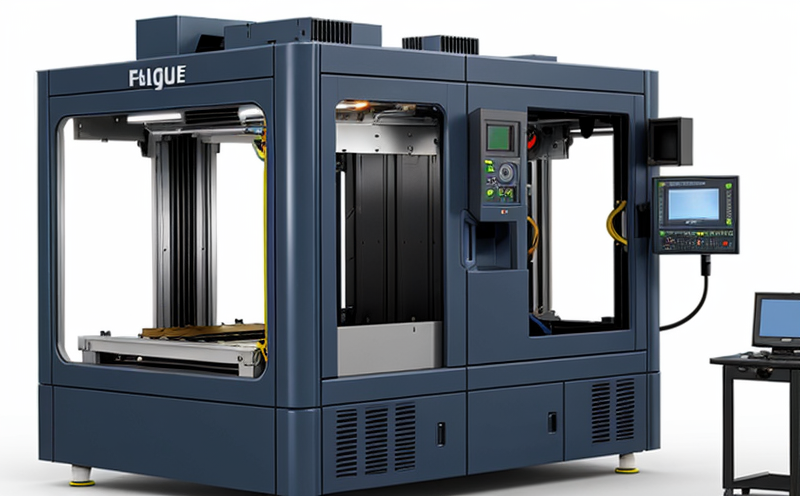ISO 12135 Fatigue Crack Resistance of Metallic Materials
The ISO 12135 standard provides a method to determine the fatigue crack resistance (KIc) of metallic materials, particularly in additive manufacturing and 3D printing applications. This test is crucial for ensuring that printed components can withstand cyclic loading without premature failure. The process involves subjecting specimens to alternating stress until fatigue cracks initiate or propagate.
The significance of this testing lies in its ability to identify weak points in the material before they become critical issues during production and use. For additive manufacturing, where layer-by-layer deposition can introduce unique microstructural features that affect mechanical properties, ISO 12135 offers a standardized approach to evaluate the integrity of printed parts.
Before testing begins, careful specimen preparation is essential. Specimens are typically machined from the same batch as the additively manufactured part or produced using similar methods. This ensures that any observed flaws can be attributed to material properties rather than manufacturing variability. The specimens should also undergo heat treatment if required by the specific additive process.
The testing itself involves applying a controlled cyclic load to the specimen until fatigue cracking occurs. The load is typically increased in steps, allowing for detailed observation of crack initiation and propagation behavior. High-precision strain gauges or extensometers may be used to measure stress and strain distributions during testing.
Once a critical crack size is reached, the test concludes. From this data, KIc values are calculated using specific formulas provided in ISO 12135. These values provide valuable insights into how resistant the material is to fatigue cracking under cyclic loading conditions.
The results of these tests are critical for quality assurance and compliance purposes. They help manufacturers ensure that their products meet safety standards and perform reliably over time. For instance, aerospace companies rely on such data when designing aircraft components or satellite structures where even minor failures could have catastrophic consequences.
Understanding the fatigue behavior of materials is especially important in sectors like automotive, medical devices, and aerospace, where parts must endure extensive wear and tear during their lifetimes. By leveraging ISO 12135 testing, engineers gain a deeper understanding of how different variables—such as microstructure, processing parameters, or environmental conditions—affect material performance.
In summary, ISO 12135 fatigue crack resistance testing plays a vital role in ensuring the reliability and longevity of metallic components fabricated through additive manufacturing techniques. Its application across various industries underscores its importance in advancing technological capabilities while maintaining safety standards.
Why It Matters
The ISO 12135 fatigue crack resistance test is essential for several reasons, especially within the context of additive manufacturing and 3D printing. One key factor is the unique microstructural features introduced by these processes that can significantly impact material performance.
- Unique Microstructures: Additive manufacturing creates parts layer-by-layer, leading to distinct grain structures compared to conventionally manufactured components. These differences influence fatigue crack initiation and propagation rates.
- Material Integrity: Ensuring that printed components do not fail due to fatigue is critical for product safety and reliability. Early detection of potential weaknesses through testing helps mitigate risks associated with operational failures.
- Regulatory Compliance: Many industries have strict regulations regarding the use of certain materials or processes, making compliance a priority. ISO 12135 provides a standardized way to demonstrate adherence to these standards.
- R&D Insights: Fatigue testing offers valuable data that can guide improvements in both material selection and process optimization for additive manufacturing.
Incorporating fatigue crack resistance testing into the quality assurance process ensures that manufacturers deliver high-quality products capable of meeting demanding performance requirements. This is particularly important given the increasing adoption of additive manufacturing across various sectors, including healthcare, automotive, and aerospace.
Eurolab Advantages
At Eurolab, we pride ourselves on providing comprehensive support for ISO 12135 fatigue crack resistance testing. Our team of experienced professionals ensures that every aspect of the process—from specimen preparation to data interpretation—is conducted with precision and accuracy.
- State-of-the-Art Facilities: Utilizing cutting-edge equipment and technology, we offer a controlled environment for conducting precise tests according to ISO 12135 standards.
- Comprehensive Expertise: Our staff includes engineers and scientists with deep knowledge of additive manufacturing and fatigue mechanics, ensuring that each test is tailored to meet specific client needs.
- Consistent Results: By adhering strictly to ISO guidelines, we guarantee consistent and reliable testing results across all projects.
- Custom Solutions: Whether you require standard tests or customized protocols, our flexible approach allows us to deliver solutions that fit your unique requirements.
We also offer additional services such as failure analysis, which can help identify the root causes of any issues found during fatigue testing. This holistic approach ensures comprehensive understanding and resolution of potential problems in additive manufacturing processes.
Choosing Eurolab for your ISO 12135 fatigue crack resistance tests not only provides peace of mind but also positions you at the forefront of technological advancements, contributing to safer and more reliable products across multiple industries.
International Acceptance and Recognition
- ISO 12135: Recognized globally for its reliability in assessing fatigue crack resistance, this standard is widely accepted by numerous international bodies including ASTM, EN, and IEC.
- Aerospace Industries: The aviation sector specifically mandates compliance with ISO standards to ensure the safety of aircraft components subjected to cyclic loading conditions.
- Automotive Manufacturers: Car manufacturers incorporate ISO 12135 results into their design processes, using these metrics to optimize material and manufacturing choices.
- Military Applications: Defense organizations worldwide rely on this testing method to validate the durability of critical components used in military equipment.
The widespread adoption of ISO 12135 underscores its significance in maintaining high standards across diverse industrial applications. By adhering to these internationally recognized protocols, companies can demonstrate their commitment to quality and safety while staying ahead of regulatory requirements.





